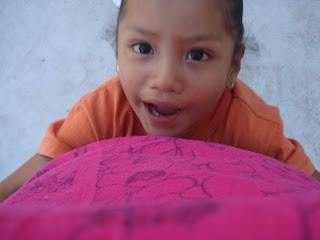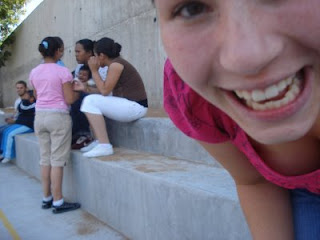My name is Kimber, and this year’s trip was my third experience working with Esperanza International. This year presented many challenges when planning this trip to Tijuana, Mexico. There was the scare of increased violence among the border towns. Then, too much dismay was the scare of the swine flu. Both times, our media rocketed out of control. The violence was between the policia and the drug cartels. The swine flu ended up being more of a danger in the United States, especially hitting close to home in New York. (Not to mention, that all the while in Mexico, I never noticed any sort of panic. Yet, while in San Diego for a short few hours… I saw plenty of people wearing face masks in public!) Nevertheless, July 5th, 2009 came and it was finally our week to help make a difference in Tijuana.

The week went fast, as it always does, but there was just something about this trip that set it apart from my others. It was definitely a combination of experiences. So, please, allow me to share.
Sunday, July 5th, we arrived at the Posada. This year we were welcomed in the midst of a fiesta. It was a joyous celebration for one of the workers who graduated high school. We were introduced and invited to celebrate as well. Our group took time to be acquainted with the members of the Seattle group as well as some of the Esperanza families present. Overall, I could not ask for any other way to arrive in Tijuana.
Monday, July 6th, our group began the first day of work. Again, this year was unique. This year was my third trip, but it was the first time we would take down a house before building the new one. The house that required demolition was a wooden house that had been constructed by a religious organization. The most insane part was that the house was built from wooden pallets… and the pallets weren’t even dismantled. Problem is a real sturdy and lasting home requires concrete. Bug infestations cannot be prevented with wooden houses in this area. The wood is not treated with pesticides as it would be in the United States. And so, the house was taken down little by little. It really was something to see. Someone in our group questioned Ines, the home owner, whether it was hard to see her home come down. Roughly translated, she shared that this was not her home. It was a house that was built for her. While she appreciates it, she never met the workers and it was impersonal. This house—that our group was helping to build, meant more to her.

Tuesday, July 7th consisted of another hard day of work. It was after this hard day of work that our group, along with the Seattle group, made a trip to Tijuana Beach to see the border. We had some time to walk along the border fence from the Mexican side. To take in and process what the border means to us, and what the border means to the Mexicans. This year, the construction of a third fence commenced. Friendship Park is no longer. Friendship Park was once a place where separated families could once meet and hold hands. While these meetings were still through a fence, there was contact. This new fence eliminated this possibility. This infuriates me. I do not believe it is necessary for one fence to be separating neighboring countries and families, not to mention three. The most shocking scene to me during this trip to the border was the marking and vandalism of the monument. Last year, there was not one mark on this monument signifying the end of one country and the beginning of another. To see such anger, resentment, and sadness expressed was just unbelievable. To me, this sight states “We’ve gone too far.”

Wednesday July 8th After another hard day of work—digging, picking, removing tires, removing nails, passing buckets of dirt, and much more, our group took our first ever trip to Casa del Migrante. The Casa has the capacity to receive 180 male migrants. It provides shelter for about two weeks, clothing, basic medical services, food, assists the men in applying for legal papers, and contacting their families. This organization is also responsible for placing crosses on the border fence for those who have passed attempting to cross the border. The crosses have the name if known, the age if known, and sometimes the city if known of the person. However, if this information is not known, not identified is written. This organization is truly amazing for all that it does. Many of us were able to hear personal stories of men at the Casa.
Thursday, July 9th This evening after work our group was able to visit the orphanage. My first year working with Esperanza International, which was two years ago, we had visited this same orphanage. To my surprise there had been wonderful donations and a new play yard had been constructed. There was a huge rush of energy as the girls came running over to play with our group. Cameras were a hot item. Every single girl wanted to take pictures of anyone and anything, pretty much everything. The next big thing was a wonderful magic trick that one of the girls decided to show us. Once that was out in the open, the magic trick would be shown to you at least once from each girl, from youngest to oldest. Capuche was also a very popular game. I did not know this Spanish term when I walked in, but on the way out I knew, and will never forget that it means piggyback ride. The one thing I did notice that evening was one of the girls that had held my hand oh-so tightly two years ago, during my first trip to that orphanage. She was older and bigger, but looked the same and responded to Fabiola. I was torn at this moment—heartbroken at first, but then pleased. This place is a glorious place. The sisters take great care of the girls and it is probably the best family one could ever ask for. Not to mention that the girls are welcome to stay as long as they want. There is no age limit. They will not get kicked out. Instead, the sisters will help the girls find apartments when it is time for them to venture out on their own.


Friday, July 10th was our last day of work and probably the most worthwhile. We dug all week. We dug about ten feet down. Digging does not show immediate progress. Digging is very slow paced. However, digging is the most important task for building a house. Without the excavation, a foundation cannot be poured. After digging all week, the last day we were able to lay the foundation bricks and begin building up the retaining wall. We took the necessary steps to insert the rebar and secure the rebar together with wires and pliers. Before lunch, we were successfully able to pour the cement. That day at lunch, we had a fiesta of our own with Ines and her family. Carne Asada was served with tortilla, avocado, frijoles, and extremely spicy items that I have learned not to eat. Lunch was delicious. But then it was time to say goodbye. And just as I am writing now—my reflections, we all shared our thoughts and emotions of the week that passed. It was time to say Adios. We took pictures, exchanged hugs, and promised to learn more Spanish for the next year. Well at least I did.
And so, with our week complete I write my reflections. But to me, it does not capture the entire spirit of the trip. It is something you have to experience for yourself. And so I urge you, if possible to experience this trip yourself. You won’t regret it. I will close with a very moving phrase written on the monument at the border “Deseo un mundo sin fronteras”. I wish for a world without borders.

No comments:
Post a Comment